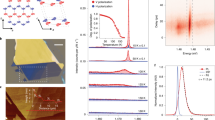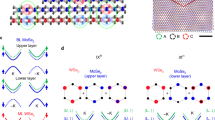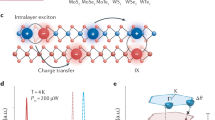Abstract
Monolayer semiconducting transition metal dichalcogenides possess broken inversion symmetry and strong spin-orbit coupling, leading to a unique spin-valley locking effect. In 2H stacked pristine multilayers, spin-valley locking yields an electronic superlattice structure, where alternating layers correspond to barriers and quantum wells depending on the spin-valley indices. Here we show that the spin-valley locked superlattice hosts a kind of dipolar exciton with the electron and hole constituents separated in an every-other-layer configuration: that is, either in two even or two odd layers. Such excitons become optically bright via hybridization with intralayer excitons. This effect is also manifested by the presence of multiple anti-crossing patterns in the reflectance spectra, as the dipolar exciton is tuned through the intralayer resonance by an electric field. The reflectance spectra further reveal an excited state orbital of the every-other-layer exciton, pointing to a sizable binding energy in the same order of magnitude as the intralayer exciton. As layer thickness increases, the dipolar exciton can form a one-dimensional Bose–Hubbard chain displaying layer number-dependent fine spectroscopy structures.
This is a preview of subscription content, access via your institution
Access options
Access Nature and 54 other Nature Portfolio journals
Get Nature+, our best-value online-access subscription
$29.99 / 30 days
cancel any time
Subscribe to this journal
Receive 12 print issues and online access
$259.00 per year
only $21.58 per issue
Buy this article
- Purchase on Springer Link
- Instant access to full article PDF
Prices may be subject to local taxes which are calculated during checkout




Similar content being viewed by others
Data availability
Source data are provided with this paper. All other data that support the plots within this paper and other findings of this study are available from the corresponding authors upon reasonable request.
References
Bistritzer, R. & MacDonald, A. H. Moiré bands in twisted double-layer graphene. Proc. Natl Acad. Sci. USA 108, 12233–12237 (2011).
Cao, Y. et al. Unconventional superconductivity in magic-angle graphene superlattices. Nature 556, 43–50 (2018).
Song, T. et al. Switching 2D magnetic states via pressure tuning of layer stacking. Nat. Mater. 18, 1298–1302 (2019).
Li, T. et al. Pressure-controlled interlayer magnetism in atomically thin CrI3. Nat. Mater. 18, 1303–1308 (2019).
Yasuda, K., Wang, X., Watanabe, K., Taniguchi, T. & Jarillo-Herrero, P. Stacking-engineered ferroelectricity in bilayer boron nitride. Science 372, 1458–1462 (2021).
Woods, C. et al. Charge-polarized interfacial superlattices in marginally twisted hexagonal boron nitride. Nat. Commun. 12, 347 (2021).
Vizner Stern, M. et al. Interfacial ferroelectricity by van der Waals sliding. Science 372, 1462–1466 (2021).
Xiao, D., Liu, G.-B., Feng, W., Xu, X. & Yao, W. Coupled spin and valley physics in monolayers of MoS2 and other group-VI dichalcogenides. Phys. Rev. Lett. 108, 196802 (2012).
Jones, A. M. et al. Spin–layer locking effects in optical orientation of exciton spin in bilayer WSe2. Nat. Phys. 10, 130–134 (2014).
Mak, K. F., He, K., Shan, J. & Heinz, T. F. Control of valley polarization in monolayer MoS2 by optical helicity. Nat. Nanotechnol. 7, 494–498 (2012).
Wu, S. et al. Electrical tuning of valley magnetic moment through symmetry control in bilayer MoS2. Nat. Phys. 9, 149–153 (2013).
Zeng, H., Dai, J., Yao, W., Xiao, D. & Cui, X. Valley polarization in MoS2 monolayers by optical pumping. Nat. Nanotechnol. 7, 490–493 (2012).
Cao, T. et al. Valley-selective circular dichroism of monolayer molybdenum disulphide. Nat. Commun. 3, 887 (2012).
Gong, Z. et al. Magnetoelectric effects and valley-controlled spin quantum gates in transition metal dichalcogenide bilayers. Nat. Commun. 4, 2053 (2013).
Shi, Q. et al. Bilayer WSe2 as a natural platform for interlayer exciton condensates in the strong coupling limit. Nat. Nanotechnol. 17, 577–582 (2022).
Yankowitz, M., McKenzie, D. & LeRoy, B. J. Local spectroscopic characterization of spin and layer polarization in WSe2. Phys. Rev. Lett. 115, 136803 (2015).
Bawden, L. et al. Spin-valley locking in the normal state of a transition-metal dichalcogenide superconductor. Nat. Commun. 7, 11711 (2016).
Slobodeniuk, A. O. et al. Fine structure of K-excitons in multilayers of transition metal dichalcogenides. 2D Mater. 6, 025026 (2019).
Liu, G.-B., Shan, W.-Y., Yao, Y., Yao, W. & Xiao, D. Three-band tight-binding model for monolayers of group-VIB transition metal dichalcogenides. Phys. Rev. B 88, 085433 (2013).
Wilson, N. R. et al. Determination of band offsets, hybridization, and exciton binding in 2D semiconductor heterostructures. Sci. Adv. 3, e1601832 (2017).
Król, M. et al. Exciton-polaritons in multilayer WSe2 in a planar microcavity. 2D Mater. 7, 015006 (2019).
Arora, A. et al. Valley-contrasting optics of interlayer excitons in Mo- and W-based bulk transition metal dichalcogenides. Nanoscale 10, 15571–15577 (2018).
Raiber, S. et al. Ultrafast pseudospin quantum beats in multilayer WSe2 and MoSe2. Nat. Commun. 13, 4997 (2022).
Shimazaki, Y. et al. Strongly correlated electrons and hybrid excitons in a moiré heterostructure. Nature 580, 472–477 (2020).
Yoo, H. et al. Atomic and electronic reconstruction at the van der Waals interface in twisted bilayer graphene. Nat. Mater. 18, 448–453 (2019).
Zhang, C. et al. Interlayer couplings, moiré patterns, and 2D electronic superlattices in MoS2/WSe2 hetero-bilayers. Sci. Adv. 3, e1601459 (2017).
McGilly, L. J. et al. Visualization of moiré superlattices. Nat. Nanotechnol. 15, 580–584 (2020).
Raja, A. et al. Coulomb engineering of the bandgap and excitons in two-dimensional materials. Nat. Commun. 8, 15251 (2017).
Wang, Z., Zhao, L., Mak, K. F. & Shan, J. Probing the spin-polarized electronic band structure in monolayer transition metal dichalcogenides by optical spectroscopy. Nano Lett. 17, 740–746 (2017).
Movva, H. C. et al. Density-dependent quantum Hall states and Zeeman splitting in monolayer and bilayer WSe2. Phys. Rev. Lett. 118, 247701 (2017).
Acknowledgements
This work was mainly supported by DoE BES (DE-SC0018171). Sample fabrication and PFM characterization were partially supported by the ARO MURI programme (W911NF-18-1-0431). The atomic force microscope-related measurements were performed using instrumentation supported by the US National Science Foundation through the UW Molecular Engineering Materials Center, a Materials Research Science and Engineering Center (DMR-1719797). W.Y. and C.X. acknowledge support from the University Grant Committee/Research Grants Council of Hong Kong SAR (AoE/P-701/20 and HKU SRFS2122-7S05). W.Y. also acknowledges support from the Tencent Foundation. Bulk WSe2 crystal growth and characterization by J.Y. were supported by the US Department of Energy, Office of Science, Basic Energy Sciences, Materials Sciences and Engineering Division. K.W. and T.T. acknowledge support from the JSPS KAKENHI (19H05790, 20H00354 and 21H05233). X.X. acknowledges support from the State of Washington-funded Clean Energy Institute and from the Boeing Distinguished Professorship in Physics.
Author information
Authors and Affiliations
Contributions
X.X. and W.Y. conceived the project. Y.Z. fabricated samples and performed measurements assisted by D.O., J.Z. and X.W. Y.Z., X.X., C.X. and W.Y. analysed and interpreted the results. C.X. and W.Y. performed calculations. T.T. and K.W. synthesized the hBN crystals. J.Y. synthesized and characterized the bulk WSe2 crystals. Y.Z., X.X., C.X. and W.Y. wrote the paper with input from all authors. All authors discussed the results.
Corresponding authors
Ethics declarations
Competing interests
The authors declare no competing interests.
Peer review
Peer review information
Nature Nanotechnology thanks the anonymous reviewers for their contribution to the peer review of this work.
Additional information
Publisher’s note Springer Nature remains neutral with regard to jurisdictional claims in published maps and institutional affiliations.
Extended data
Extended Data Fig. 1 Optical reflectance spectra in monolayer and bilayer WSe2.
a-b, Electric field (Ez) dependence of differential optical reflectance measurement in monolayer (a) and bilayer (b) WSe2. Doping is fixed at zero. As expected, the every-other-layer dipolar exciton as well as the anti-crossing feature are not observed.
Extended Data Fig. 2 Electric field EZ dependence of photoluminescence spectra in trilayer WSe2.
In addition to the dR/R data presented in the maintext, we examine photoluminescence (PL) spectra and its EZ field dependence on the same trilayer WSe2. Near K-K direct transition region (around 1.7 eV), we find similar anti-crossing feature as dR/R spectra, supporting the formation of every-other-layer dipolar excitons. The field-independent PL feature around 1.76 eV is instrument artefact.
Extended Data Fig. 3 Modeling and simulating the every-other-layer dipolar exciton.
a, EZ dependence of measured differential reflectance spectra in trilayer WSe2. The green dashed lines show the curve fitting results based on the Hamiltonian Eq. (2) + (3). b, Simulation results after considering the spectral intensity and width. c, d, Same plots for 5-layer WSe2.
Source data
Source Data Fig. 1
Statistical data for Fig. 1.
Source Data Fig. 2
Statistical data for Fig. 2.
Source Data Fig. 3
Statistical data for Fig. 3.
Source Data Fig. 4
Statistical data for Fig. 4.
Source Data Extended Data Fig.1
Statistical data for Extended Data Fig. 1.
Source Data Extended Data Fig. 2
Statistical data for Extended Data Fig. 2.
Source Data Extended Data Fig. 3
Statistical data for Extended Data Fig. 3.
Rights and permissions
Springer Nature or its licensor (e.g. a society or other partner) holds exclusive rights to this article under a publishing agreement with the author(s) or other rightsholder(s); author self-archiving of the accepted manuscript version of this article is solely governed by the terms of such publishing agreement and applicable law.
About this article
Cite this article
Zhang, Y., Xiao, C., Ovchinnikov, D. et al. Every-other-layer dipolar excitons in a spin-valley locked superlattice. Nat. Nanotechnol. 18, 501–506 (2023). https://doi.org/10.1038/s41565-023-01350-1
Received:
Accepted:
Published:
Issue Date:
DOI: https://doi.org/10.1038/s41565-023-01350-1
This article is cited by
-
Functional nanoporous graphene superlattice
Nature Communications (2024)
-
New excitons in multilayer 2D materials
Nature Reviews Physics (2024)
-
Highly tunable ground and excited state excitonic dipoles in multilayer 2H-MoSe2
Nature Communications (2024)
-
Giant optical nonlinearity of Fermi polarons in atomically thin semiconductors
Nature Photonics (2024)
-
Layered materials as a platform for quantum technologies
Nature Nanotechnology (2023)



